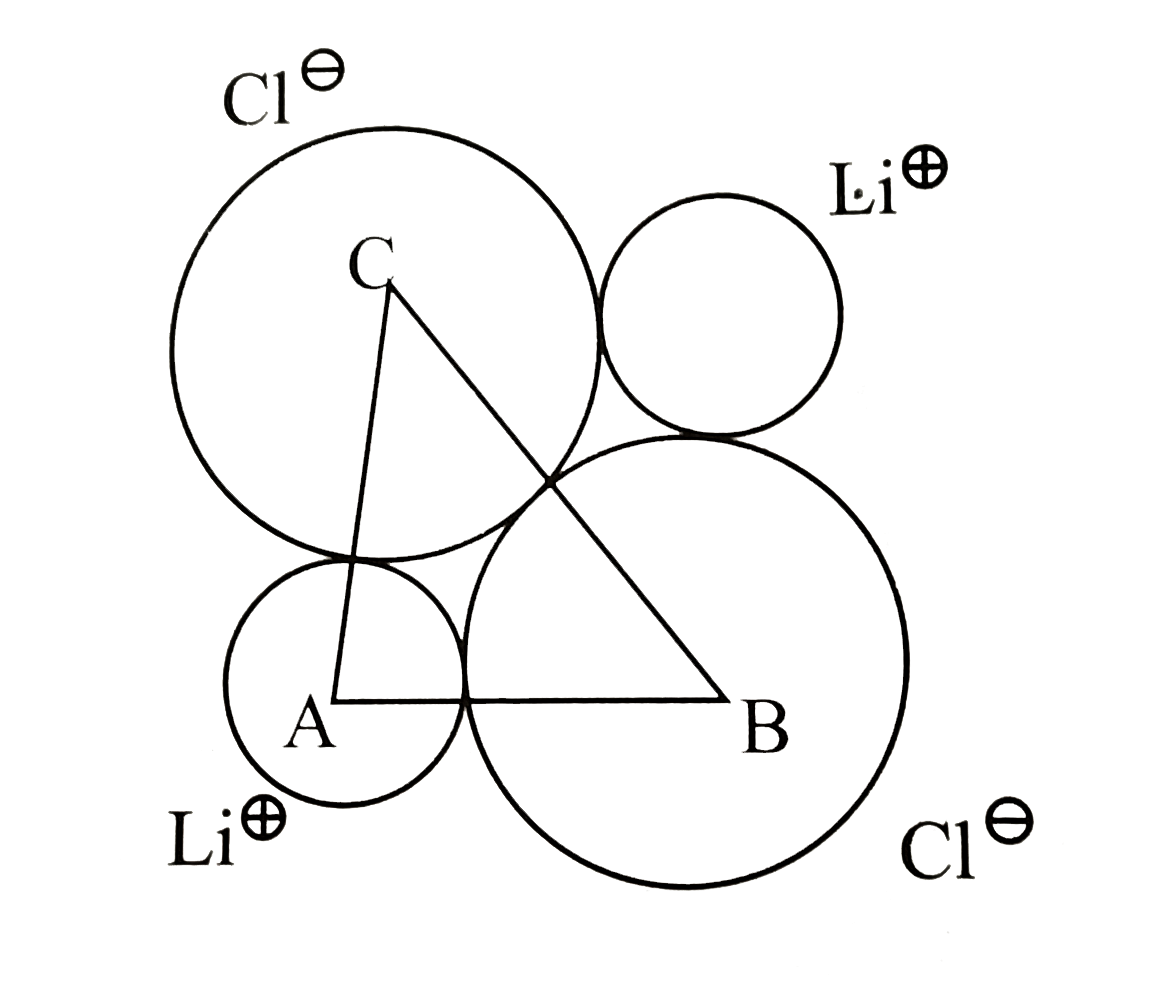The unit cell cube length for LiCl(just like NaCl structures) is 5.14Å. Assuming anion-anion contact, the ionic radius for chloride ion is:
128.5 pm
257 pm
181.7 pm
None of the above
The correct Answer is:C
To solve the problem of finding the ionic radius for the chloride ion in LiCl, we will follow these steps:
Step 1: Understand the Structure
LiCl has a face-centered cubic (FCC) structure similar to NaCl. In this structure, the chloride ions (Cl⁻) are arranged in an FCC lattice.
Step 2: Identify the Unit Cell Length
The given unit cell length (edge length) for LiCl is a=5.14Å.
Step 3: Calculate the Face Diagonal
In an FCC structure, the face diagonal can be calculated using the formula:
Face Diagonal=√2⋅a
Substituting the value of a:
Face Diagonal=√2⋅5.14Å
Step 4: Relate Face Diagonal to Ionic Radii
In the FCC structure, the face diagonal is also equal to the sum of the diameters of the ions along that diagonal. Since there are two ions (one from each corner of the face), we have:
Face Diagonal=4r
where r is the ionic radius of the chloride ion.
Step 5: Set Up the Equation
Equating the two expressions for the face diagonal:
4r=√2⋅5.14Å
Step 6: Solve for Ionic Radius r
Rearranging the equation to solve for r:
r=√2⋅5.14Å4
Step 7: Calculate the Value
Calculating the value:
r=1.414⋅5.144≈7.254≈1.8125Å
Step 8: Convert to Picometers
Since the options are given in picometers, we convert angstroms to picometers. We know that:
1Å=100pm
Thus,
r≈1.8125Å×100pm/Å≈181.25pm
Final Result
The ionic radius for the chloride ion is approximately 181.25pm.
LiCl has a face-centered cubic (FCC) structure similar to NaCl. In this structure, the chloride ions (Cl⁻) are arranged in an FCC lattice.
The given unit cell length (edge length) for LiCl is a=5.14Å.
In an FCC structure, the face diagonal can be calculated using the formula:
Face Diagonal=√2⋅a
Substituting the value of a:
Face Diagonal=√2⋅5.14Å
In the FCC structure, the face diagonal is also equal to the sum of the diameters of the ions along that diagonal. Since there are two ions (one from each corner of the face), we have:
Face Diagonal=4r
where r is the ionic radius of the chloride ion.
Equating the two expressions for the face diagonal:
4r=√2⋅5.14Å
Rearranging the equation to solve for r:
r=√2⋅5.14Å4
Calculating the value:
r=1.414⋅5.144≈7.254≈1.8125Å
Since the options are given in picometers, we convert angstroms to picometers. We know that:
1Å=100pm
Thus,
r≈1.8125Å×100pm/Å≈181.25pm
The ionic radius for the chloride ion is approximately 181.25pm.
Similar Questions
The unit cube length for LiCl (NaCl structure) is 5.14Å. Assuming anion-anion contact, calculate the ionic radius for chloride ion.

View SolutionThe unit cell edge length of NaF crystal is 4.634Å. If the ionic radius of Na+ ion is 95 pm, what is the ionic radius of F− ion, assuming that anion-anion contact and face centred cubic lattice?
View SolutionEdge length of M+X− (fcc structure) is 7.2∘A. Assuming M+−X− contact along the cell edge, radius of X(−) ion is (rM+=1.6∘A):
View SolutionSilver crystallises in a face centred cubic unit cell. Each side of the unit cell has a length of 500 pm. Calculate radius of the silver atoms (Assume that the atoms just touch each other on the diagonal across the face of the unit cell i.e. each face atom is touching four atoms)
View SolutionIf the edge-length of the unit cell of sodium chloride is 600 pm, and the ionic radius of CI− ion is 190 pm, then the ionic radius of Na+ ion is
View SolutionCesium chloride forms a body-centred cubic lattice. Cesiumm and chloride ions are in contact along the body diagoanl of a cell. The length of the side of the unit cell is 412± and ClΘ ion has a radius of 181 pm. Calculate the radius of Cs⊕ ion.
View SolutionKF has ccp structure. Calculate the radius of the unit cell if the edge length of the unit cell is 400 pm. How many F− ions and octahedral voids are there in the unit cell ?
View SolutionThe edge length of a face-centred cubic unit cell is 508pm. If the radius of the cation is 110pm the radius of the anion is
View SolutionThe edge length of a face centred cubic cell of an ionic substance is 508 pm .If the radius of the cation is 110 pm the radius of the anion is
View SolutionThe edge length of a face-centred cubic unit cell is 508 pm. If the radius of the cation is 110 pm the radius of the anion is
View Solution
